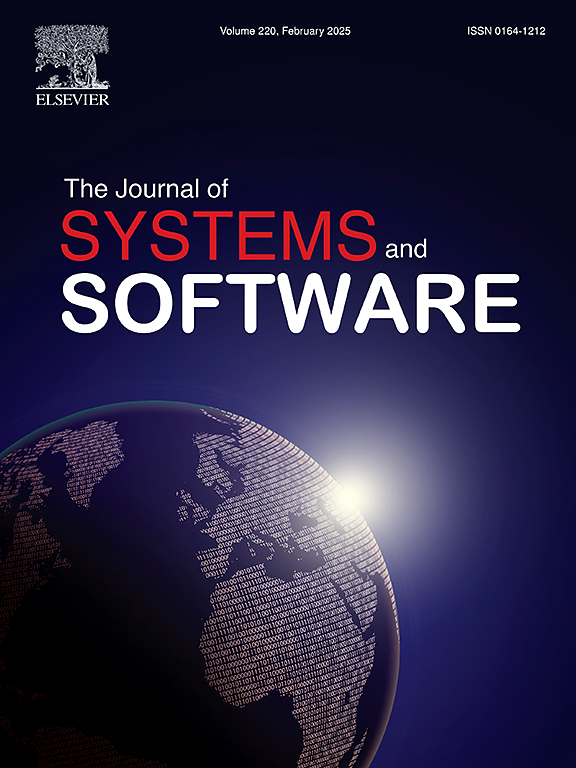微服务系统中的变更影响分析:系统性文献综述
IF 3.7
2区 计算机科学
Q1 COMPUTER SCIENCE, SOFTWARE ENGINEERING
引用次数: 0
摘要
背景:变更影响分析在软件开发中至关重要,尤其是在处理大型复杂系统时。它旨在确定变更的潜在后果,或估算为完成变更需要修改的内容。在分散环境中,这种分析的重要性成倍增加。微服务系统是分散式的,代表了当前可扩展系统的行业主流。目标:虽然单个微服务打算自成一体、独立存在,但由于它们之间存在交互,因此与其他微服务之间的某些重叠是不可避免的。在微服务系统中,一个微服务的变化可能会影响到其他没有直接联系的微服务,从而导致连锁反应和维护工作的延长。为了了解微服务在变更影响分析方面的技术现状,这项工作的目的是研究和分析现有文献,总结证据,为读者提供既定方法的路线图。方法:我们针对与微服务变更影响分析相关的研究进行了系统的文献综述。结果:本手稿介绍了文献中介绍的不同类型的变化影响。它对文献中用于衡量微服务变化影响的工具和方法进行了比较和分类。它说明了所使用的衡量单位。最后,它还分享了用于评估变革影响分析方法的系统基准。这些挑战与检测技术的改进、额外的影响分析和方法验证有关。许多解决方案只测量受影响系统的一个特定方面,而不考虑多重影响。影响分析在这些解决方案中也被视为间接测量,需要更直接的观察。结论:研究结果为微服务开发人员和质量工程师维护更高质量的系统提供了参考。有了这一主题的路线图,我们的同行研究人员可能会很容易理解这一主题的各种研究方向。最后,这项工作可作为开发辅助工具的参考,帮助管理微服务系统的演进。本文章由计算机程序翻译,如有差异,请以英文原文为准。
Change impact analysis in microservice systems: A systematic literature review
Background:
Change impact analysis is crucial in software development, especially when working with large and complex systems. It aims to identify the potential consequences of a change or estimate what needs to be modified to accomplish a change. The importance of such an analysis multiplies in decentralized environments. Microservice systems are decentralized and represent the current industry mainstream for scalable systems.
Objective:
While individual microservices intend to be self-contained and independent, certain overlap with other microservices is inevitable since they interact. In the context of microservice systems, changes in one microservice can affect other microservices without a direct connection, leading to ripple effects and extended maintenance efforts. To understand the current state of the art for microservices with respect to the change impact analysis, the objective of this work is to study and analyze existing literature to summarize the evidence and to provide readers with a roadmap to established approaches.
Methods:
We conduct a systematic literature review targeting studies related to change impact analysis in microservices. The study considered 1,669 papers and filtered them down to 29 works included in this study.
Results:
This manuscript introduces different types of change impacts introduced in the literature. It compares and categorizes tools and methods that have been used in literature to measure the impact of change in microservices. It illustrates what units of measure have been used. Finally, it shares system benchmarks used to assess change impact analysis methods.
Open Challenges.
A number of open challenges and gaps are found in the tools and methods. These challenges are related to the improvement of the detection techniques, additional impact analysis, and validation of approaches. Many of the solutions measure a specific aspect of an impacted system, without taking into account multiple effects. Impact analysis is seen as measured indirectly by these solutions as well, and more direct observation is needed.
Conclusion:
The results provide a reference to microservice developers and quality engineers to maintain better-quality systems. With a roadmap to the topic, our researcher peers might easily understand various directions that have been approached on this topic. Finally, this work serves as a reference for development-aiding tools helping to manage microservice system evolution.
求助全文
通过发布文献求助,成功后即可免费获取论文全文。
去求助
来源期刊

Journal of Systems and Software
工程技术-计算机:理论方法
CiteScore
8.60
自引率
5.70%
发文量
193
审稿时长
16 weeks
期刊介绍:
The Journal of Systems and Software publishes papers covering all aspects of software engineering and related hardware-software-systems issues. All articles should include a validation of the idea presented, e.g. through case studies, experiments, or systematic comparisons with other approaches already in practice. Topics of interest include, but are not limited to:
•Methods and tools for, and empirical studies on, software requirements, design, architecture, verification and validation, maintenance and evolution
•Agile, model-driven, service-oriented, open source and global software development
•Approaches for mobile, multiprocessing, real-time, distributed, cloud-based, dependable and virtualized systems
•Human factors and management concerns of software development
•Data management and big data issues of software systems
•Metrics and evaluation, data mining of software development resources
•Business and economic aspects of software development processes
The journal welcomes state-of-the-art surveys and reports of practical experience for all of these topics.
 求助内容:
求助内容: 应助结果提醒方式:
应助结果提醒方式:


